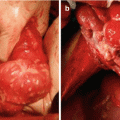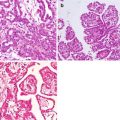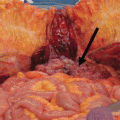Drug
Category
Systemic use
Area under the curve
Dose (mg/m2)
Carboplatin
Platinum analog
Ovarian, bladder, esophageal, sarcoma
10
300
Cisplatin
Platinum analog
Ovarian, bladder, endometrial esophageal, gastric
6.6 [3]
90
Oxaliplatin
Platinum analog
CRC, ovarian, esophageal, stomach, pancreas
13.2 [3]
460
Doxorubicin
Topoisomerase II inhibitor
Bladder, endometrial sarcoma
78 [4]
15
Mitomycin C
Antibiotic
Stomach, pancreas
15
Melphalan
Alkylating agent
Ovarian
33 [8]
70
Etoposide
Topoisomerase II inhibitor
Ovarian
47 [9]
25–350
Irinotecan
Topoisomerase I inhibitor
CRC, esophageal, sarcoma, gastric, pancreas
200
Paclitaxel
Taxane derivative
Ovarian, bladder, esophageal, gastric, sarcoma
Docetaxel
Taxane derivative
Gastric, bladder esophageal, sarcoma, ovarian
45
5-Fluorouracil
Pyrimidine analog
CRC, gastric, pancreas, bladder, esophageal
650
2.2 Pharmacology
The use of intraperitoneal chemotherapy is more invasive and challenging than conventional intravenous administration. Therefore intraperitoneal administration should have a pharmacologic advantage resulting in an increased cytotoxic effect on peritoneal tumor cells. The rationale of administrating chemotherapeutic drugs through the intraperitoneal route is based on the blood peritoneal barrier. The blood peritoneal barrier results in a decreased uptake of chemotherapy from the intraperitoneal cavity, which permits high concentrations of intraperitoneal chemotherapy with a limited systemic uptake. Consequently, intraperitoneal administration of chemotherapy can result in significant intraperitoneal cytotoxicity with limited systemic side effects. Importantly, selected drugs should have an increased cytotoxicity following dose intensification, resulting in an increased cytotoxicity after intraperitoneal administration.
The blood peritoneal barrier may decrease the effect of intravenous chemotherapy, which may partly explain the limited effect of systemic chemotherapy on peritoneal metastases. Numerous studies have shown the limited effect of systemic chemotherapy on peritoneal metastases. Franko et al. showed in a pooled analysis of two large randomized controlled trials of 2,095 patients with metastasized colorectal cancer treated with modern systemic chemotherapy that patients with peritoneal metastases have a significantly shorter overall and progression-free survival compared to patients with peritoneal metastasis [18]. Population-based data has shown that although there is an increased usage of systemic chemotherapy in patients with peritoneal metastases of colorectal and gastric cancer, the overall survival in the entire patient group has hardly increased, which supports the paradigm that systemic chemotherapy has only a limited effect on peritoneal metastases [19, 20].
The pharmacologic advantage of intraperitoneal administration of chemotherapy can be described by the area under the curve (AUC) ratio. The AUC is defined as the plot of concentration of drug in blood plasma or peritoneal perfusate against time. The AUC ratio is calculated by dividing the AUC in the perfusate by the blood plasma. Thus the AUC ratio reflects the increased exposure of the peritoneum compared to blood plasma, i.e., a high AUC reflects high peritoneal concentrations and presumable high local efficacy. However, one important consideration is that AUC ratio does not reflect tissue penetration. A very high AUC ratio may reflect insufficient tissue penetration resulting in a decreased efficacy. It is difficult to adequately determine the tissue penetration of HIPEC treatment. Some studies have shown a penetration of several millimeters; however, penetration to only a few cell layers has also been described [21, 22]. Furthermore, tissue samples after cessation of the HIPEC are not available. Probably, part of chemotherapy remains incorporated in the tissues surrounding the peritoneal cavity. Rapid systemic metabolism and excretion also influences the AUC ratio. Rapidly metabolized and excreted of the chemotherapeutic drug in the plasma results in less systemic toxicity.
Interestingly, in a study of 145 patients with colorectal or appendiceal carcinomatosis who underwent cytoreductive surgery combined with HIPEC using mitomycin, the number of peritonectomies did not influence the uptake of intraperitoneal chemotherapy [5]. Only large visceral resections such as total colectomies and gastrectomies resulted in a decrease of uptake of intraperitoneal chemotherapy.
As in systemic chemotherapy, dosage of intraperitoneal chemotherapy is currently based on the body surface area of a patient (m2). As shown by cadaver studies, there is a correlation between the peritoneal surface area and body surface area, and the peritoneal surface area can be estimated by formulas used to calculate body surface area [23]. However, peritoneal surface disease such as pseudomyxoma peritonei may significantly influence the peritoneal surface area; by forming large amounts of mucus, the size of peritoneal area may be increased. Furthermore, dosage on body surface area does not incorporate the volume of the peritoneal cavity, which can also significantly differ inter-individually. The chance of an inadequate dosing in a patient is probably larger when using a fixed dose of chemotherapy per patient (mg). For instance, in a patient with a limited peritoneal surface area, but with a relatively large peritoneal cavity, using a fixed concentration could result in a concentration on the peritoneal surface which is inadequate to induce cytotoxicity. Previous studies have used a standard concentration dosage (mg/l) in HIPEC; this could lead to toxic plasma levels in patients with a relatively large peritoneal surface area. Therefore a concentration based on the body surface of a patient currently seems to be the most appropriate dosing system in HIPEC treatment.
2.3 Colorectal Cancer
In colorectal cancer, mitomycin is the most frequently used and studied drug in the treatment of peritoneal metastases with HIPEC. A first randomized clinical trial to compare CRS with HIPEC using mitomycin vs. systemic chemotherapy showed a survival benefit of 9 months with CRS and HIPEC arm (21.6 versus 12.6 months, p = 0.032) [24]. Mitomycin is frequently dosed at 35 mg/m2 for 90 min HIPEC. Following the fast breakdown of mitomycin, administration is administrated at multiple times during the 90 min HIPEC. At initial stage of HIPEC, half of the dose is administered, and after 30 and 60 min another one-quarter is added to the perfusate. Mitomycin has favorable pharmacokinetics for intraperitoneal usage. Van der Speeten et al. investigated the pharmacokinetics of mitomycin in 145 patients treated with a 90 min HIPEC with a single dose of 15 mg/m2 [5]. The authors calculated a AUC ratio in these patients of 27. At the start of the perfusion, the peak intraperitoneal concentration was 10 μg/mL, which was significantly higher compared to a peak plasma concentration of 0.25 μg/mL following 30 min of HIPEC. After 90 min of perfusion, in the remaining perfusion fluid 29% of mitomycin was measured and 9% was excreted in the urine.
Intraoperative administration of mitomycin has been shown to be safe and not produce a hazard to the surgical personnel [25]. Consequently, from its cytotoxic effect, local effects such as decreased wound healing and possibly increased rate of postoperative complications, such as anastomotic leakage, are shown in animal studies [26, 27]. However, mitomycin is the widely used drug in HIPEC in large groups of patients, therefore the local toxicity and systemic toxicity of mitomycin are described extensively, showing acceptable morbidity and mortality [28, 29]. In clinical studies, systemic and dose-limiting toxicity in mitomycin is neutropenia; however, in daily clinical practice, this is a relatively rare clinically relevant complication.
In vitro, multiple studies have shown that cytotoxicity of mitomycin is increased using hyperthermia [30, 31]. There is limited data on the clinical relevancy of heat augmentation in HIPEC treatment; however, the appliance of hyperthermia in intraoperative intraperitoneal perfusion is not demanding or costly. Furthermore, no negative side effects of hyperthermia are currently reported.
Following the beneficial effect of oxaliplatin in colorectal cancer both as first-line systemic treatment and as an adjuvant chemotherapeutic drug [32, 33], Elias et al. extensively investigated oxaliplatin as an intraperitoneal chemotherapeutic drug for the use in HIPEC treatment [34, 35]. A pioneering dose escalation study showed that during a 30 min HIPEC a dose of 460 mg/m2 can be administered safely [36]. They performed HIPEC at an intraperitoneal temperature of 42–44 °C. Additionally, plasma levels of intraperitoneal oxaliplatin (460 mg/m2) remained below historical reports of plasma levels after systemic administration of oxaliplatin. During intraperitoneal chemotherapy with oxaliplatin, intravenous 5-fluorouracil (400 mg/m2) and leucovorin (20 mg/m2) was administered at the start of HIPEC perfusion. This strategy was chosen as oxaliplatin as monotherapy is considered to be relatively ineffective in systemic chemotherapeutic treatment regimens [37].
In early studies, oxaliplatin is used with a 5% dextrose carrier solution, as oxaliplatin is considered to be relatively unstable in chloride-containing solutions. However, recent in vitro studies have shown that degradation of oxaliplatin is limited, less than 10% after 30 min and less than 20% after 2 h [38]. Furthermore, using dextrose as carrier solution has been associated with severe hyperglycemia and electrolyte disturbances [39].
Two studies have compared HIPEC treatment with mitomycin or oxaliplatin. Hompes et al. performed a comparison of 39 patients treated with oxaliplatin and 56 patients with mitomycin [40]. The extent of peritoneal spread was significantly higher in patients treated with oxaliplatin. Neutropenia only occurred in patients treated with mitomycin (26.8%). After statistical correction for the extent of PC, a comparable intra-abdominal complication rate was seen in both groups. In the oxaliplatin group, median recurrence-free survival was 12.2 months and 13.8 months in the mitomycin group (p = 0.87). Median overall survival is 37.1 months in the oxaliplatin group and 26.5 months in the mitomycin group (p = 0.45). The authors concluded that no clear benefit of either drug could be demonstrated in the study regarding recurrence-free and overall survival.
In a comparison performed by the American Society of Peritoneal Surface Malignancies of 539 patients treated with either mitomycin of oxaliplatin after complete macroscopic cytoreduction, median overall survival was 31.4 months for the oxaliplatin group and 32.7 months for the mitomycin group (p = 0.925) [41]. Also a stratified analysis was performed using the peritoneal surface disease severity score (PSDSS), a score incorporating clinical symptoms, extent of peritoneal spread, and histology. In patients with PSDSS 1/2 median overall survival rates was 54.3 months in those receiving mitomycin versus 28.2 months in those receiving oxaliplatin (p = 0.012). Median overall survival in PSDSS 3/4 patients was 19.4 months in the mitomycin group versus 30.4 months in oxaliplatin group (p = 0.427). The authors conclude that in patients with a low disease burden of colorectal peritoneal metastases mitomycin seems a superior drug compared to oxaliplatin.
2.4 Ovarian Cancer
Primary or interval cytoreductive surgery combined with systemic chemotherapy is regarded as standard treatment in patients with advanced-stage epithelial ovarian cancer. As epithelial ovarian cancer confines to the abdominal cavity for much of its natural history, administering chemotherapy directly into the peritoneal cavity is attractive. In ovarian cancer, many studies have focused on multiple administrations through catheters of intraperitoneal chemotherapy following cytoreductive surgery. Meta-analysis of nine randomized controlled trials, investigating the beneficial effect of adding intraperitoneal chemotherapy to a standard treatment regime, has shown that intraperitoneal chemotherapy increases progression-free and overall survival in advanced ovarian cancer [42]. However, catheter-related adverse events are prevalent, and major complications have been described [43, 44]. Adverse events result in discontinuation of therapy in more than half of patients, before completing six cycles of intraperitoneal chemotherapy [45]. Hyperthermic intraoperative intraperitoneal chemotherapy may overcome the problems associated with repetitive catheter-based intraperitoneal chemotherapy. A meta-analysis of 37 studies investigating cytoreductive surgery and HIPEC in advanced and recurrent epithelial ovarian cancer showed improved survival rates both compared to CRS alone. Furthermore in this analysis, morbidity and mortality rates were similar [46].
Different chemotherapeutic drugs are used from HIPEC treatment in ovarian cancer. Cisplatin is currently the most frequent drug for intraperitoneal use in ovarian cancer (REFS). Selection of systemic chemotherapy in ovarian cancer is based on the platinum resistance or sensitivity [47]. In a randomized controlled trial by Spiliotis et al., cisplatin and paclitaxel were used in platinum-sensitive disease and doxorubicin and paclitaxel or mitomycin in platinum-resistant disease [48]. Survival was significantly better in the HIPEC group with 26.7 months compared to 13.4 months in the group only undergoing cytoreductive surgery (p < 0.006). In the group treated with HIPEC, survival was not different between patients with platinum-sensitive disease or platinum-resistant disease (26.6 vs. 26.8 months). An analysis of the HYPER-O registry, an internet-based registry collecting data from collaborating institutions, compared the effect of different chemotherapy agents on survival [49]. In the entire group of patients, carboplatin was associated with an improved overall survival compared to mitomycin (p = 0.003) or cisplatin (p = 0.003). When comparing patients with platinum-sensitive recurrent ovarian cancer, carboplatin resulted in a significantly improved survival versus cisplatin (p = 0.012) and mitomycin (p = 0.011). There was no significant difference between chemotherapeutic drugs in platinum-resistant disease. This study shows that platinum resistance may also be of importance in ovarian cancer treatment with HIPEC. Bakrin et al. described 246 prospectively studied patients with ovarian cancer undergoing HIPEC with cisplatin in 95.5% of procedures, alone or in combination with doxorubicin or mitomycin. Median overall survival was 48 months for patients with platinum-resistant recurrent disease and 52 months for patients with platinum-sensitive recurrent disease, which is superior to historically reported survival rates in this patient group [50]. Currently five randomized controlled trials are being performed investigating the role of HIPEC in ovarian cancer; all are using cisplatin 75–100 mg/m2, and one added paclitaxel 175 mg/m2 to their intraperitoneal drug regime [51].
2.5 Gastric Cancer
In gastric cancer after potentially curative treatment, locoregional and peritoneal recurrences are the most frequent sites of treatment failure [52]. In patients with peritoneal carcinomatosis of gastric cancer, survival is poor, with a median survival of about 3 months [53]. In gastric cancer, many randomized controlled trials have been performed in Asia investigating the role of prophylactic HIPEC in patients at high risk for intraperitoneal recurrence. A recent meta-analysis concluded that this treatment may prevent local recurrence and improve survival [54]. In patients with established peritoneal metastases, one randomized controlled trial has been performed investigating the efficacy and safety of HIPEC with cisplatin and mitomycin. This study showed a significant median overall survival improvement in cytoreductive surgery combined with HIPEC group compared to cytoreductive surgery alone (11.0 versus 6.5 months, p = 0.046) [55]. Complication rates did not differ in both groups.
Originating from its widespread usage and experience in other malignancies, mitomycin C is the most frequently investigated drug in HIPEC for gastric cancer. Mitomycin C has only limited effect in systemic treatment of gastric cancer, therefore other agents should be investigated for the use in HIPEC in gastric cancer patients.
The platinum-based agents oxaliplatin and cisplatin have both been investigated for HIPEC in gastric cancer. In vitro and in systemic treatment, oxaliplatin seems a more potent drug in gastric cancer [56, 57]. Furthermore, pharmacological advantages after intraperitoneal administration have been described for oxaliplatin compared to cisplatin [3, 58]. The adverse effects of cisplatin and oxaliplatin following intraperitoneal administration are acceptable, and limited hematological toxicity has been described [59, 60]. There are currently no studies in humans comparing intraperitoneal cisplatin and oxaliplatin. An enhanced in vitro efficacy in hyperthermic conditions has been demonstrated for oxaliplatin and cisplatin.
Stay updated, free articles. Join our Telegram channel

Full access? Get Clinical Tree






